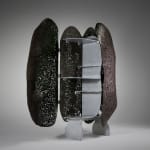Studio Furthermore
Hydra Cabinet, 2025
Powder-coated aluminium
H. 200 x W. 120 x D. 51 cm
H. 78 3/4 x W. 47 1/4 x D. 20 1/8 inches
H. 78 3/4 x W. 47 1/4 x D. 20 1/8 inches
Copyright The Artist
Photo: Graham Pearson
Further images
-
(View a larger image of thumbnail 1
)

-
(View a larger image of thumbnail 2
)

-
(View a larger image of thumbnail 3
)

-
(View a larger image of thumbnail 4
)

-
(View a larger image of thumbnail 5
)

-
(View a larger image of thumbnail 6
)

-
(View a larger image of thumbnail 7
)

-
(View a larger image of thumbnail 8
)

-
(View a larger image of thumbnail 9
)

-
(View a larger image of thumbnail 10
)

-
(View a larger image of thumbnail 11
)

Meticulously hand-sculpted from iridescent metal foam, Studio Furthermore's Hydra cabinet is intended to become a doorway into the mind of a collector, knowledgeable of the past while engaged in decoding...
Meticulously hand-sculpted from iridescent metal foam, Studio Furthermore's Hydra cabinet is intended to become a doorway into the mind of a collector, knowledgeable of the past while engaged in decoding and unravelling the future. The Hydra cabinet, the result of a technologically advanced process devised and handmade by Studio Furthermore, is highly sculptural and asymmetric in form. A pair of angel-winged doors open to reveal a layered universe of translucency, illuminated by shimmers of light.
Cabinets of curiosity, typically large cupboards or rooms containing artifacts and rarities, date back to 16th-century Europe and were the precursors to museums. Aristocrats would assemble esoteric collections of fossils, dried insects, works of art, and more, reflective of their taste and identity. Often driven by a desire to gain greater insight into the world, collectors could construct for themselves their own version of reality. Inversely, the cabinet offered a physical doorway into the curated mind of the collector.
Cabinets of curiosity, typically large cupboards or rooms containing artifacts and rarities, date back to 16th-century Europe and were the precursors to museums. Aristocrats would assemble esoteric collections of fossils, dried insects, works of art, and more, reflective of their taste and identity. Often driven by a desire to gain greater insight into the world, collectors could construct for themselves their own version of reality. Inversely, the cabinet offered a physical doorway into the curated mind of the collector.
Join our mailing list
* denotes required fields
We will process the personal data you have supplied to communicate with you in accordance with our Privacy Policy. You can unsubscribe or change your preferences at any time by clicking the link in our emails.










